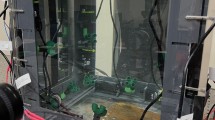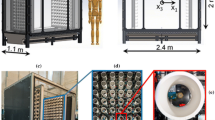Abstract
We measure the flow above an array of randomly driven, upward-facing synthetic jets used to generate turbulence beneath a free surface. Compared to grid stirred tanks (GSTs), this system offers smaller mean flows at equivalent turbulent Reynolds numbers with fewer moving parts.

Similar content being viewed by others
Notes
We define synthetic jets in the broadest sense, such that the net mass flux, integrated over either space or time, is zero for each synthetic jet, i.e., an incurrent and excurrent port coupled via a pump or a single port that oscillates in time between incurrent and excurrent flows.
Because we cannot use Taylor’s frozen field hypothesis in facilities of this nature, Re λ and Re are estimated from spatial data in PIV measurements made in a previous generation of the facility. PIV was taken in a 2 cm×2 cm plane with 0.1-mm resolution. From the velocity field in x and z, we can find the autocorrelation functions, which we then integrate to obtain L≈0.3 cm. We find ε from local gradients and by fitting to power spectra (Cowen and Monismith 1997; Liao and Cowen 2002).
We find that urms is proportional to UJ; thus, Re is proportional to UJ.
References
Birouk M, Sarh B, Gokalp I (2003) An attempt to realize experimental isotropic turbulence at low Reynolds number. Flow Turbul Combust 70:325–348
Bourdel T (2000) Description of prototype jet-array turbulent mixer. Internal report, Department of Physics, Cornell University. Available at http://milou.msc.cornell.edu/publications2.html
Brumley B, Jirka G (1987) Near-surface turbulence in a grid-stirred tank. J Fluid Mech 183:235–263
Chu C, Jirka G (1992) Turbulent gas flux measurements below the air–water interface of a grid-stirred tank. Int J Heat Mass Transfer 35(8):1957–1968
Cowen E, Monismith S (1997) A hybrid digital particle tracking velocimetry technique. Exp Fluids 22:199–211
DeSilva I, Fernando H (1994) Oscillating grids as a source of nearly isotropic turbulence. Phys Fluids 6(7):2455–2464
Efron B, Tibshirani R (1993) An introduction to the bootstrap. Chapman and Hall, New York
Fernando H, DeSilva I (1993) Note on secondary flows in oscillating-grid, mixing-box experiments. Phys Fluids A 5(7):1849–1851
Hopfinger E, Toly J (1976) Spatially decaying turbulence and its relation to mixing across density interfaces. J Fluid Mech 78(1):155–175
Hwang W, Eaton J (2004) Creating homogeneous and isotropic turbulence without a mean flow. Exp Fluids 36(3):444–454
Liao Q, Cowen E (2002) The information content of a scalar plume—a plume tracing perspective. Environ Fluid Mech 2(1–2):9–34
McDougall T (1979) Measurements of turbulence in a zero-mean-shear mixed layer. J Fluid Mech 94(3):409–431
McKenna S (2000) Free-surface turbulence and air–water gas exchange. PhD thesis, Massachusetts Institute of Technology, with advisor McGillis WR. Cited values read from Figs. 6–15
Mydlarski L, Warhaft Z (1996) On the onset of high Reynolds number grid generated wind tunnel turbulence. J Fluid Mech 320:331–368
Thompson S, Turner J (1994) Mixing across an interface due to turbulence generated by an oscillating grid. J Fluid Mech 67(2):349–368
Villermaux E, Hopfinger E (1994) Periodically arranged co-flowing jets. J Fluid Mech 263:63–92
Acknowledgements
The authors gratefully acknowledge the financial support of the National Science Foundation (grant No. CTS-0093794). Any opinions, findings, and conclusions or recommendations expressed in this material are those of the author(s) and do not necessarily reflect the views of the National Science Foundation. The authors wish to thank Thomas Bourdel, who built the excellent tank into which this facility was retrofitted. We also would like to acknowledge the hard work and expertise of Dr. Monroe Weber-Shirk, Lee Virtue, Paul Charles, and Jack Powers in creating this facility.
Author information
Authors and Affiliations
Corresponding author
Rights and permissions
About this article
Cite this article
Variano, E.A., Bodenschatz, E. & Cowen, E.A. A random synthetic jet array driven turbulence tank. Exp Fluids 37, 613–615 (2004). https://doi.org/10.1007/s00348-004-0833-z
Received:
Accepted:
Published:
Issue Date:
DOI: https://doi.org/10.1007/s00348-004-0833-z




